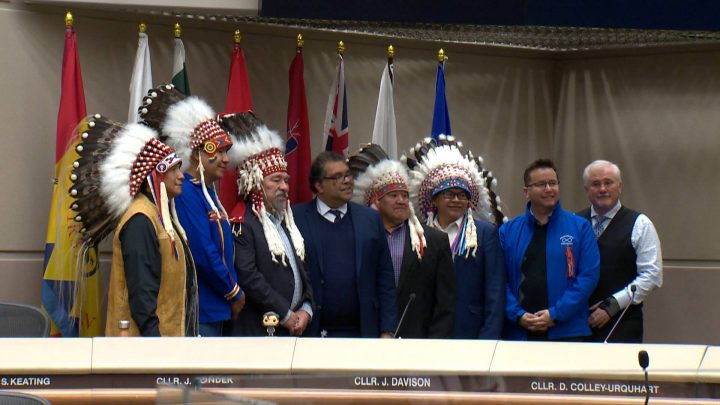The flags of all member nations of Treaty 7 and the Métis Nation of Alberta Region 3 are permanently on display Calgary city council chambers.

“We live in a time of reconciliation, where new relationships between Indigenous and non-Indigenous Canadians are being created based on mutual recognition of the past and mutual respect,” Mayor Naheed Nenshi said.
“It allows us to feel that sense of belonging, that we’re not excluded but rather included in the day-to-day dealing with the City of Calgary,” Piikani First Nation Chief Stanley Grier said.
The city has been working to engage all member nations of Treaty 7, the Métis Nation of Alberta Region 3, and the Calgary Aboriginal Affairs Committee since receiving direction from council last year.
In August 2018, council adopted recommendations from the Calgary Aboriginal Urban Affairs Committee to add the flags.
Chiefs representing the nations said the flags represent a step towards reconciliation.

Get daily National news
“Hopefully this will demonstrate and convey to all peoples that come into the city of Calgary — to our territory — that we have a partnership, a strong historical partnership between the original inhabitants and the newcomers,” Grier said.
“Where our lands were traditionally held, what we used to call our homes, we went out and we shared it with the early pioneers. I think today is a significant day bringing that forward and seeing it’s part of reconciliation with Canada and the City of Calgary,” Bearspaw First Nation Chief Darcy Dixon said.
“It’s a recognition in the spirit of reconciliation and I appreciate that. I applaud Mayor Nenshi and this council for taking this opportunity to make sure that this happens,” said Chiniki First Nation Chief Aaron Young.
The flags in council chambers are displayed in alphabetical order from left to right; Bearspaw, Blood/Kainai, Chiniki, Piikani, Siksika, Tsuut’ina, Wesley and Métis.


Comments